UGC: User-Generated Content to Boost E-commerce Sales
User-generated content (UGC) can be an important sales driver if used correctly. We'll explore exactly what it is and how your shop can benefit from it.
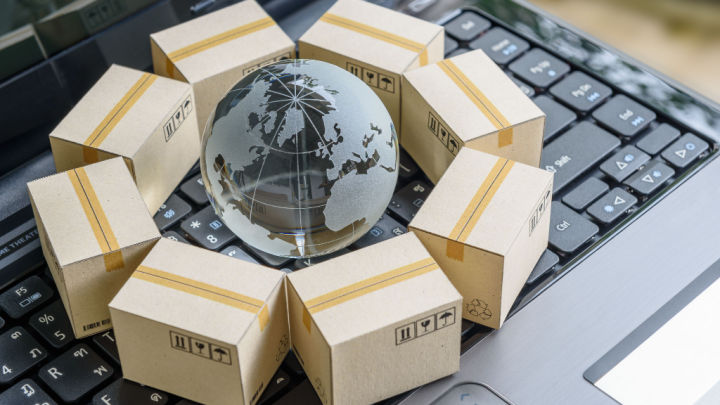
Although the e-commerce sector in Europe suffered a significant decline in the first quarter of this year due to inflation, this does not change the fact that it is still seen as one with huge potential, particularly in the area of cross-border sales.
The possibility of scaling businesses, improving the whole supply chain, and reaching new groups of online buyers in different countries offers the prospect of increased sales volumes and higher revenues, which remains a dream for many ambitious online retailers.
However, it seems that instead of dreaming, it's time to act because the way to sell internationally is now much easier! And I will try to prove it in today's post.
The online shopping revolution, accelerated by the COVID-19 pandemic, has not only encouraged a growing number of people to shop online (somehow forced to do so by sanitary restrictions put on brick and mortar stores) but also made them far more willing to buy from abroad.
According to data collected by Eurostat for 2021, showing the % of individuals who have made online purchases for personal use in the last three months, more than 30% have chosen to buy cross-border from sellers in other European countries and more than 20% chose to make such a purchase from sellers outside the EU. Unsurprisingly, the survey also shows that young people between 16 and 24 and slightly older people from 25 to 54 completed the most cross-border purchases.
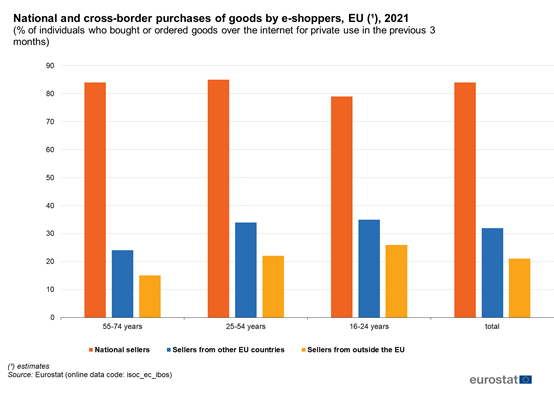
Furthermore, global market figures compiled by AllTheResearch indicate that cross-border e-commerce is expected to reach US$ 2,248.57 billion by 2026! Which means a CARG (Compound Annual Growth Rate) of 17.4%. It is clear then, that the stakes are high.
Many e-commerce businesses still believe that cross-border trade is possible only years after the start of sales in their home country. And besides that, they are afraid of the problems associated with supply chains and cross-border logistics in general: international shipping by multiple carriers, delays at last-mile delivery, and returns (in logistics terminology it's called reverse logistics). However, it's not as bad as it seems.
It cannot be denied, that launching sales in a new market involves investment and additional costs, so if money is the primary issue, setting up a profitable business in the origin country is a must. Yet, if the online business owner has the necessary resources, then there is no need to wait a few years just for the sake of principle.
Thanks to technological progress and the capabilities of today's modern logistics, running international trade is no longer an extremely complicated and difficult task. Or, I should say, it is not so complicated when a reliable logistics partner provides support in this field.
But let's not get ahead of ourselves. I have gathered the main facts on how to cross international borders, so everything will become clear in a moment!
Research, compare, decide - this is the place to start. Depending on the product category, you may have more or less work to do, but doing the research is a must.
Let me shed some light on shopping habits and customer expectations - following the European E-commerce Report 2022, the most popular products and services (also digital services) purchased online in 2021 are:
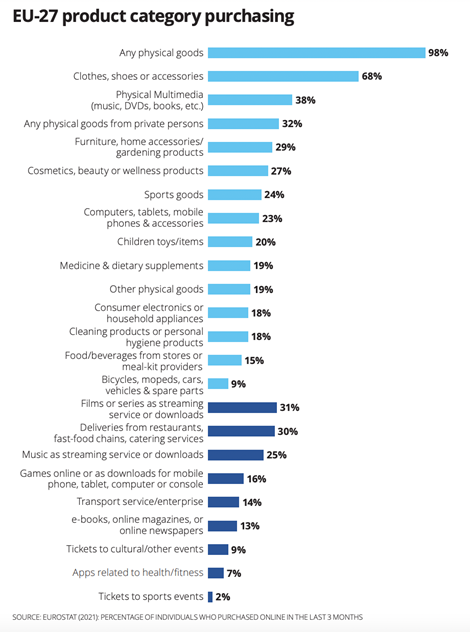
Market demand will vary, so to identify those that are promising for your business, you should do the deepest possible analysis of the new markets. Government sources and websites will be helpful, and the trade department of your home country's embassy may be able to provide useful information and reports on shopping online.
Please note that in this case, you will also need to look at what consumers expect: where do they buy frequently, which payment methods are most popular, what are the average shipping costs, how often do they use the free shipping option, and which forms of delivery are preferred. Not to mention the local language aspect. Contrary to what some may think, the elements I have mentioned are part of the logistics activities you need to take care of.
The better you know your future cross-border customers, the higher the chances of success!
A lot will depend on how you decide to handle your orders. The fulfillment process has its own flow, and you will have to ensure it. The most popular model for selling online abroad is to work with a 3PL (third-party logistics) company or an entire fulfillment network - which I will talk more about later in the article.
Basically, this means outsourcing order fulfillment to another company. Whether you sell locally or internationally, you will need to have a good warehouse management system in place to enable efficient order picking and provide effective inventory management so that you are aware of the flow of goods.
Thanks to the cooperation with an external logistics operator and the technological connection of the systems offered, such information will become easily accessible and should be updated regularly. This will allow you to maintain greater control over the entire process, even though it will be carried out by another company.
Remember, however, that in a third-party logistics model, you will be still responsible for contact with your suppliers and for stocking any missing products. Therefore, take care to coordinate timely delivery, so that you do not have to worry about product shortages. This also helps build customer loyalty, as shoppers are more likely to return to those online sellers who provide a constant supply of goods.
Choosing the right set of products is a highly significant step in planning cross-border sales, a key element of your marketing strategy, and an essential one from a logistical perspective.
Following the previous steps mentioned above increases your chances of success, but it doesn’t guarantee it.
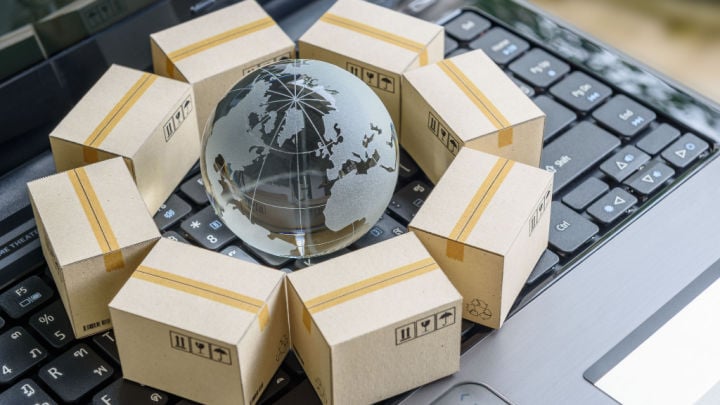
Shutterstock/William Potter
The first rule to remember is: don't try to start selling all your products at once. The larger the product range, the more difficult it is to handle flexibility and the possibility to change the logistics process. In fact, it is easier to withdraw goods or transport them to another warehouse in the destination country when the quantities are smaller. Also, there is no denying that this will have an impact on costs, something worth controlling to save money.
Overseas customer demands may surprise you, and not always in a positive way. Start by selecting a core product line to test over the next few weeks in your target market. Observe sales and optimise your advertising. Once you are satisfied with the results, gradually expand your offer with products related to your basic line-up.
Using this approach helps limit your losses and gives you chance to modify your strategy when needed.
If you want cross-border selling to work, you need to know exactly where you can do it. Are shoppers more likely to use individual online shops? Or do they much prefer marketplaces?
For most countries, the answer will be marketplaces, such as Amazon, eBay, Zalando, or Allegro. And this is a sales channel that can offer you many advantages as a retailer. Above all, it will provide you with an established sales infrastructure, support in customer service, and logistical handling. The first steps in running a business internationally can be made much easier thanks to that.
This is the perfect solution for those of you who still think it's quite demanding to work with a logistics operator. By using the fulfillment service offered by marketplaces, you can gain many advantages on the e-commerce platform itself - such as awards and promotions. You don't have to worry about finding the right provider, shipping options, and delivering parcels, you can profit from what the marketplace has to offer just from the start.
However, the negative aspect is that this way, you can only deal with online orders coming through a specific platform. If you want to expand your presence and open your own online shop, you will still have to look for other shipping partners.
This point is especially useful for all of you who are confident in successful cross-border trade. Perhaps you have already launched your international expansion and are thinking about developing it further?
The fulfillment network can be a great asset here. This solution is basically a third-party logistics service with a comprehensive reach, covering not only a particular country but often the entire continent. This means that within the fulfillment network, you have the full logistics support in other countries - from warehousing to order delivery to the end customer. I could say that it's a kind of automated system, giving you an overview of the ongoing fulfillment stages and all shipping details that you can supervise from anywhere you want.
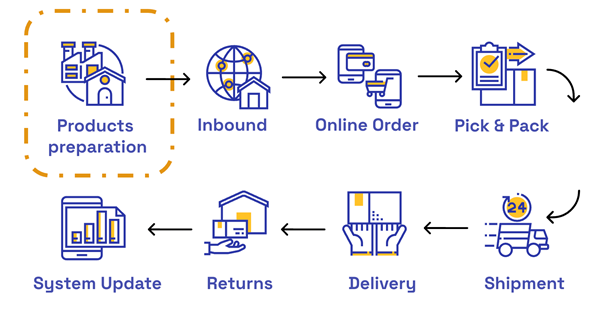
Example of an e-commerce fufillment process (Source: Linkedcloud)
As this is not very popular yet, it's good to mention the competitive advantage of this solution. Or even a few.
Primarily, it can guarantee fast shipping thanks to the storage and distribution of goods by regional carriers. The same applies to the delivery costs, as local dispatching makes it possible to offer competitive prices to domestic retailers. Secondarily, it greatly simplifies the returns procedure, which can be routed to warehouses in the country concerned, rather than returning to the place of origin.
The entire order handling process can be adapted to the requirements of the business, from eco-friendly packaging to product sets prepared on the fly, so it can make a huge, positive impression on the customer experience.
Last but not least, it takes a burden off online businesses to manage logistical processes in a foreign market, which can be challenging due to language and/or cultural differences. This definitely makes international selling more accessible and less complicated.
Even though business predictability is limited in these uncertain times, the crisis may provide an opportunity for many online stores to strengthen their market position. Growing cross-border commerce is just an example of this.
Getting ready to maximise online sales in foreign countries requires market research and in-depth knowledge of the customer's shopping behaviour. An effective purchasing process is then in place to ensure business growth.
Making such a decision surely brings a certain amount of concern and may not be easy at all. It is important to remember that high customer satisfaction should remain at the heart of your efforts, as it will play a role in your international success too.
27/08/22User-generated content (UGC) can be an important sales driver if used correctly. We'll explore exactly what it is and how your shop can benefit from it.
What is the Community of Trust? How do you gain access to the 45 million shoppers in it? And how do you improve your conversions, AOV, and more?